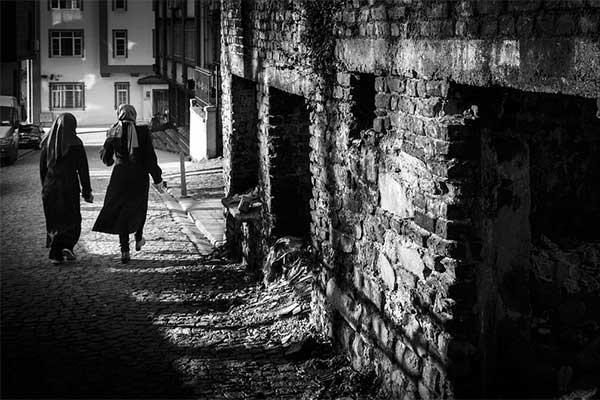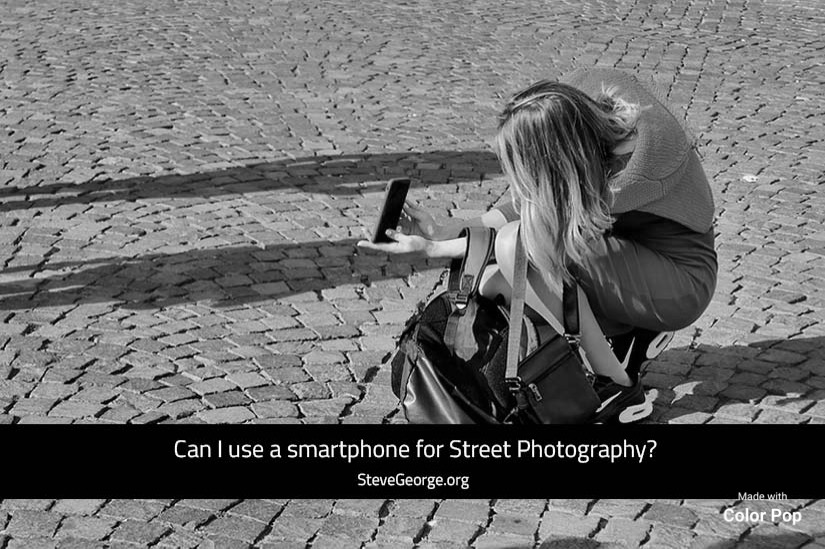So you want to know if you can use your smartphone for street photography? Well, in my opinion, it’s definitely yes! Personally, I love my smartphone for street photography (I generally use my iPhone 11).
I never have to ‘remember’ to take my camera when I go out. It’s always with me and produces images that I’m generally happy with.
Do I ever wish I had a dedicated camera with me? Of course.
Sometimes, I’ll come across a subject that would benefit from a camera with a large sensor, to bring out more detail, or get a better exposure, etc. But it doesn’t happen very often.
And, when it does happen, I can usually go back the following day and get the shot anyway.

However, I’d like to give you 10 reasons why using an iPhone (or any smartphone), for street photography is a good idea.
10 Reasons to use your smartphone for Street Photography
- If you use your smartphone for street photography, you always have your camera with you. I know from personal experience, before phones had cameras, I’d often rue not bringing my heavy dSLR out with me when a photographic situation occurred that I wasn’t expecting.
- Street photography is all about capturing things as they happen. Or as Henri Cartier-Bresson called it… “the decisive moment”. Image quality isn’t the most important thing with street photographs. With portrait photography, for example, clear, sharp eyes are paramount. In street photography, it’s the emotion of an image that’s important. And a smartphone can do that as well as any dedicated camera can.
- The majority of successful images you’ll take, will likely be destined for the internet. If you don’t need to print large images, a smartphone will easily satisfy your requirements.
- It’s usually great in auto mode. Although your smartphone will have a wide aperture, the software inside does a great job of providing an image that’s generally sharp throughout the image. This means that if you see something happen that you weren’t expecting, just pressing the shutter button will usually get you a suitable result.
- You never have to look like you’re taking a photo of someone. With a smartphone, you can use the volume button as a shutter release. This means you can stealthily shoot to your heart’s content, without bringing attention to it. (provided of course, you turn off the shutter sound in settings) I use a cheap bluetooth remote with my iPhone. I can hold the phone with one hand, while I merrily shoot photos using my other hand, which is in my pocket!1
- Smartphones have big screens! It’s easy to view different perspectives, simply by moving the phone. It’s much more difficult to get satisfactory low-to-the-ground shots, when you have to compose on a 3 inch camera screen.
- You don’t need a camera bag. If you like the idea of having some different lens additions2, you can get good quality lenses from manufacturers like Moment and Apexel. But, unlike a dSLR, those lenses will easily slip into your pocket.
- Smartphones have quality cameras. Sure, if you want to print an image bigger than about 10×8, you’ll probably struggle to keep the quality high enough. But that’s due to the small sensor size3. The quality of smartphone lenses today is remarkable. Many manufacturers use optics from the likes of Leica, Hasselblad and Zeiss (who make lenses for Canon, Nikon and Sony). And the built-in software takes care of many of the sensor’s shortcomings.
- You can take your smartphone camera almost anywhere. Many exhibitions, sporting events, concerts, etc. won’t let you take a dedicated camera into the venue. It’s VERY unusual for you to be refused entry with your smartphone.
- You can edit on-the-go, and have your masterpiece live on social media almost instantly. There are literally hundreds of different photo editing apps available for your smartphone. In many cases, you can just make the adjustments you want, or use a preset, or filter and upload.
But, obviously there are some drawback to using a smartphone for street photography. Here’s a few to consider.
Reasons to not use a smartphone for Street Photography
- The dynamic range isn’t always great on a smartphone. If you like making images where there’s a lot of contrast eg. bright highlights and deep shadows, you might find the smartphone camera finds it difficult to keep the details in these areas. Having an HDR setting can sometimes help, but the image doesn’t always look ‘real’ with HDR.
- Low light images can be poor quality. Because of the sensor size3, it’s difficult to keep detail without a lot of ‘noise’ in the image. The dedicated cameras have a much bigger sensor, so noise in low-light images can be kept to a minimum.
- Battery life. Dedicated cameras have removable batteries, and for a few quid each, you can keep spares in your pocket. Most smartphones don’t have removable batteries, so once it’s run down, your day’s shooting is over.
- Your composition has to be right if you’re using a smartphone for your street photography. Because the sensors are so small3, you can’t really afford to crop view much in post-processing without losing quality.
Note: Most of these issues arise because of the restrictions smartphones have because of their small sensor.
For more info on camera sensors and how they affect the images, you should read this article from Capture The Atlas.
Conclusions
Personally, I use my iPhone 11 for most of my street photography. It’s simple to operate quickly, it produces an image quality that I’m generally happy with and I don’t make large prints.
Generally, I only spend a few hours at a time out on the streets, so battery life isn’t really a problem.
If I do decide to spend all day out, I have a rechargeable power bank that I can take with me. And that’s is enough to see me through.
If you intend to make fairly large prints, you should probably look for a camera with a bigger sensor.
Remember that pixel count isn’t the same as sensor size.
You can have a smartphone for your street photography that has 108 mega-pixels, or a full-frame camera that has 12 mega-pixels. But, if you’re printing anything bigger than about 10″x8″ images, the 12MP camera will always produce better quality.

1. Yes, I realise that’s cheating, but I still get pretty anxious at the moment. If I’m ‘caught’, and asked if I took a photo of them, I’m always honest and I offer to email them a copy, or delete the image if asked to.
2. I have 6 lenses for my iPhone, and don’t use any of them for my street photography.
3. The average smartphone sensor is 4.5mm x 3.4mm. A dSLR can have a sensor up to 36mm x 24mm.

